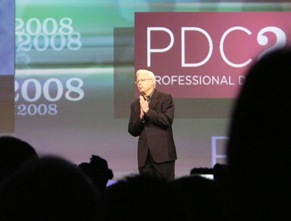Microsoft are clearly getting in touch with their Arty side. The most recent evidence came today when they announced Windows Azure; earlier hints can be found in “Silverlight” and Project Indigo (which later became WCF).
 Windows Azure is Microsoft’s new Cloud Operating System. Not an Operating System in the sense of something that you install on your PC, but an Operating System in that it provides a layer of abstraction upon which interesting things can be built. Just as Windows XP or Windows Vista abstract away the messiness of interacting with keyboard, mouse, graphics card, disk drives, etc. to provide a nice API with which developers can do interesting things, so Windows Azure abstracts away the difficulties of purchasing hardware for data-centres, provisioning machines with identical copies of code, configuring load-balancers, backing up databases etc. and provides a nice programming model and user interface to streamline all those things.
Windows Azure is Microsoft’s new Cloud Operating System. Not an Operating System in the sense of something that you install on your PC, but an Operating System in that it provides a layer of abstraction upon which interesting things can be built. Just as Windows XP or Windows Vista abstract away the messiness of interacting with keyboard, mouse, graphics card, disk drives, etc. to provide a nice API with which developers can do interesting things, so Windows Azure abstracts away the difficulties of purchasing hardware for data-centres, provisioning machines with identical copies of code, configuring load-balancers, backing up databases etc. and provides a nice programming model and user interface to streamline all those things.
We were shown a demo of a standard ASP.Net application being packaged up and tagged with a config file. This package was then submitted to the Azure portal, where it was given a url and then published. It was instantly available at that address. The magic came when they pretended that load on the application had increased, and more computing power was needed: just changing a number in the config file was sufficient to scale the application out across another couple of machines – Windows Azure taking care of the details.
Another component is the cloud storage. They have an API that allows Blobs, Queues and simple Tables to be managed in the cloud, with space being provided elastically. All the data is available through REST APIs, with a .Net object model on top for easier access through managed code.
And of course we developers need our tools, so there is a Windows Azure SDK which you can download today. This provides templates for Visual Studio, but more importantly, it provides a mini-version of the Azure platform for your desktop, so that you can build and test applications without needing to upload them.
In the CTP that they released today only managed code is supported, but the intention is to allow native code, and other languages like PHP in the near future. Also in the future will be a “Raw” mode that will allow Virtual Machines to be hosted in the cloud a la Amazon’s EC2.
The intention is to release this commercially in 2009, though Microsoft apparently will be guided by the community as to when they think it is ready.




0 comments:
Post a Comment